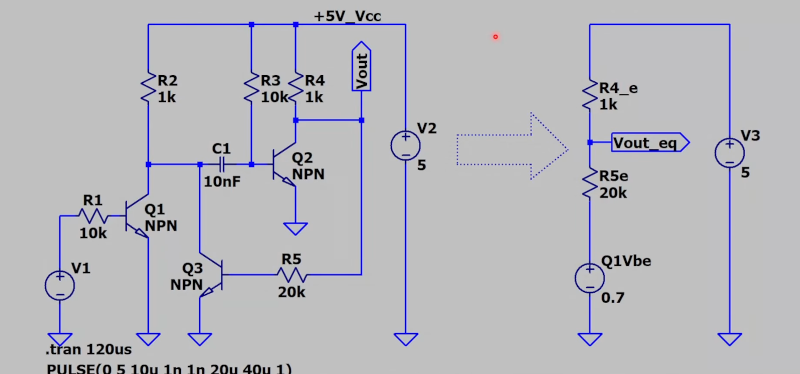[The Engineering Experience] has an ambitious series of videos. He’s working through circuit examples from the awesome book “The Art of Electronics.” In the latest installment, he’s looking at a pulse generator that uses bipolar transistors. So far, there are 43 videos covering different exercises.
If you’ve read the book — and you should — you know the examples and exercises sometimes have little explanation. Honestly, that’s good. You should try to work through them yourself first. But once you have an idea of how it works, hearing someone give their take on it may help you out. In fact, even if you don’t have the book, we’d suggest pausing the video and looking at the circuit to see what you can figure out before playing the explanation. You’ll learn more that way.
Admittedly, some of the early videos will be cakewalks for Hackaday readers. The first few, for example, walk through parallel and series resistors. However, if you are starting out or just want a refresher, you can probably enjoy all of them. The later ones get a bit more challenging.
If you want to double-check your work, you can simulate the circuit, too. Our simulation got 4.79 V and he computed 4.8, which is certainly close enough.
We do love “The Art of Electronics.” The book’s author also enjoys listening for aliens.















I unfortunately never took up electronics (again) after retiring from the Air Force some 30 years ago. Before my stint in the Air Force, as a kid, I was all about electronics. Vacuum tube electronics. Super easy to understand (even as a 14 year old) and super forgiving if grid bias voltages were not exactly to spec. (And you get a real nice red glow on the plate from the massive surge of electrons when you accidentally short out the plate load resistor!) But it occurred to me, while reading this article, that even without an actual circuit in front of me (and meters, an oscilloscope, a signal generator, etc.) just reading a text might prove very interesting. And a circuit simulator would add even more to the fascination. Thanks a bunch for this article! Steven Gates
How do you short out a resistor? Isn’t the resistor’s job to be “shorted”? Oracle admin, Austin Florida.
I have done this twice in the last 30 years with my 91-92 2nd edition (grey-silver cover), from start to finish. I have the latest edition, so it is high time for me to repeat the exercise (no new databooks for bedtime reading)… :-)
.ic V(CAP_NODE)=VCC
or
.ic I(IND)=VERY_SMALL_CURRENT
There!
Another book that we used was MIT’s Electronic Circuits and Applications by Stephen Senturia and Bruce Wedlock; 1975.
Aaah, Howitzer and Hillbilly, yes, we used that back when I did my RO training, end of the ’80s.
A great Bible indeed. Utilized it to understand switch mode supplies. Made my own 4ch LED SM current mode supply that used the Vf for temperature measurement.
When we were starving students my wife bought me the brand-new 2nd edition. It cost over a week of grocery money. A real keeper: I still have both the wife and the book. (plus now the 3rd and X editions)
I find more instructive and fun examples are the “Bad circuits” pages, sadly not in the 3rd edition. Some of them are not so obvious why they won’t work, and it can be a bit of a puzzle.
I’d like to give a shout out for the Art of Electronics Students Manual – the first spiral bound edition. This is a structured course based on the Art of Electronics. I worked through this book twice using a simulator for the exercises. Smaller and more approachable than the Silver Bible.
Hello,
I am Rahul and I run the Engineering Experience channel. First of all, thank you for the post.
I started this channel to learn Electronics myself and give my self motivation to finish the books. The questions so far have been solvable although some did take a long time. I think it will be community to get good solutions for all the questions but should be fun!
I am still really enjoying the series and have started making videos on practicals for the circuits aswell.
If you have feedback for me, please let me know.